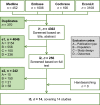The Economic Burden of Non-Alcoholic Steatohepatitis: A Systematic Review
- PMID: 35789987
- PMCID: PMC9300564
- DOI: 10.1007/s40273-022-01140-y
The Economic Burden of Non-Alcoholic Steatohepatitis: A Systematic Review
Abstract
Background: The global prevalence of non-alcoholic steatohepatitis (NASH) is increasing, such that NASH is predicted to become the leading cause of liver transplantation (LT) in the US by 2025. Despite this, data on the economic burden of NASH are limited.
Objectives: This systematic literature review aimed to summarise and critically evaluate studies reporting on the economic burden of NASH and identify evidence gaps for subsequent research.
Methods: Medline, EMBASE, the Cochrane Library and EconLit were searched up to 6 January 2021 for English language articles published from January 2010 to January 2021 inclusive that reported economic outcomes of a NASH population or subpopulation. Evidence was presented and synthesised using narrative data analysis, and quality was assessed by two reviewers using an 11-item checklist developed for economic evaluations and adapted to cost of illness.
Results: Fourteen studies were included, of which five presented data on costs and resource use, four on costs only and five on resource use only. Overall, NASH is associated with a significant and increasing economic burden in terms of healthcare resource utilisation (HCRU) and direct and indirect costs. This burden was higher among NASH patients with advanced (fibrosis stage 3-4) versus early (fibrosis stage 0-2) disease, symptomatic versus asymptomatic disease and for patients with complications or comorbidities versus those without. In LT patients, those with NASH as the primary indication had greater HCRU and higher costs compared with non-NASH indications such as hepatitis B and C viruses. Considerable variability in HCRU and costs was seen across the US and Europe, with the highest costs seen in the US. The quality of the included studies was variable, and the studies themselves were heterogeneous in terms of study methodology, patient populations, comorbidities, follow-up time and outcomes measured.
Conclusions: This review highlights a general scarcity of NASH-specific economic outcomes data. Despite this, the identified studies show that NASH is associated with a significant economic burden in terms of increased HCRU, and high direct medical and non-medical costs and societal burden that increases with disease severity or when patients have complications or comorbidity. More national-level NASH prevalence data are needed to generate accurate forecasts of HCRU and costs in the coming decades.
Funding: Novo Nordisk A/S, Søborg, Denmark.
Plain language summary
It is important to know the cost of treating different diseases because this helps to guide how healthcare resources and funds are used. Non-alcoholic steatohepatitis (NASH) is a serious liver disease that can lead to liver scarring (cirrhosis), liver transplantation and early death, and the number of people with NASH is growing around the world. Fourteen studies published over the past 10 years have investigated the costs of treating patients with NASH. Patients with NASH generally use more healthcare services with a higher cost than the general population or patients with type 2 diabetes. In people with more serious liver disease, such as liver transplant patients, NASH tends to be more expensive and use more healthcare services than other serious liver diseases such as hepatitis. Costs and use of health services are particularly high in patients with more severe NASH, or those who have other diseases or complications in addition to NASH (such as type 2 diabetes or kidney failure).
© 2022. The Author(s).
Conflict of interest statement
SIM, PJ and MA are employees of Novo Nordisk A/S or Novo Nordisk Denmark A/S, and JF was formerly an employee of Novo Nordisk A/S. SIM, PJ, MA and JF are also shareholders of Novo Nordisk A/S. MW and SN are employees of DRG Abacus (Clarivate), who were commissioned to perform this systematic literature review by Novo Nordisk A/S.
Figures

References
-
- Flisiak-Jackiewicz M, Bobrus-Chociej A, Wasilewska N, Lebensztejn DM. From nonalcoholic fatty liver disease (NAFLD) to metabolic dysfunction-associated fatty liver disease (MAFLD)-new terminology in pediatric patients as a step in good scientific direction? J Clin Med. 2021;10(5):924. doi: 10.3390/jcm10050924. - DOI - PMC - PubMed
Publication types
MeSH terms
LinkOut - more resources
Full Text Sources
Medical
Miscellaneous

